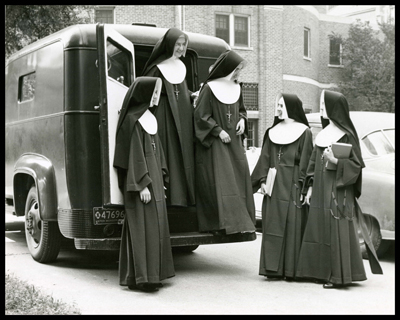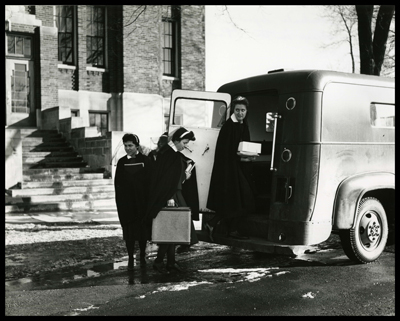

Paddy Wagon Pedagogy

In the 1950s and early 1960s, Sisters Mary Johnice and Mary Elizabeth, directors of the Religious Education Resource Center at Marygrove College in Monroe, Michigan, disliked the out-of-date Christian education materials used to teach Catholic children. The black and white print and irrelevant content compared poorly to the colorful books and media in their school textbooks and recreational reading resources.
The sisters contacted other dioceses in the country looking for fresh ideas for books with youth appeal. They asked each diocese to send samples of what they used in order to create a resource center for novices who taught catechism to children in the rural areas surrounding Monroe. As the samples came in, so did responses from dissatisfied educators. They, too, wanted new ideas instead of the materials they had found lacking. Sisters Mary Johnice and Mary Elizabeth got busy.
The sisters sought permission to give the religious education program a “makeover.” They approached various religious publishers requesting their religious education books, and those publishers, in turn, asked the sisters to serve as translation consultants on materials from other countries. This work took them to France to study under Canon Andre Boyer, a long-admired monk. As they translated his books, they adopted his style and philosophy.
As part of the college faculty and their religious order--Sisters, Servants of the Immaculate Heart of Mary—they were suddenly in demand. Writing a screenplay for a religious film in Hollywood led to other films. They selected the best illustrators of the day for the art in their books - Martin and Alice Provensen, Caldecott Award winning artists for their book The Glorious Flight. The Provensens’ art was compelling and brought children into the stories. The religious education materials became much in demand. With quality resources for the postulants to take to the children in the county, one problem remained – transportation. The needs from the outlying churches became more and more difficult to meet.

Fortunately, the Detroit Police Department was selling several patrol wagons, perfect transportation for postulants and nuns. The sisters painted their wagon blue which hardly disguised its original use as a paddy wagon. Nuns traveled comfortably all around the area in their wagon, well-heated in the back—a necessity in Michigan winters.
In a very short period of time, Sisters Mary Johnice and Mary Margaret accomplished their goal of reaching all the children in the Monroe area. They managed to knock down any roadblocks in the way of accomplishing their mission—literally!
For more information about the sisters and their work, look at the finding aid for the Elizabeth Fowkes and Helen Cohan Papers. If you have questions, please contact Ellen Ruffin, the curator of the de Grummond Children’s Literature Collection, at or 601.266.6543.
Text by Ellen Ruffin, Curator of the de Grummond Children’s Literature Collection.